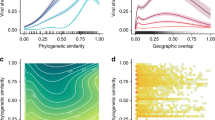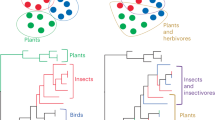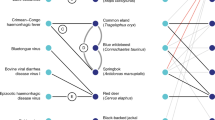Abstract
Present estimates suggest there are over 1 million virus species found in mammals alone, with about half a million posing a possible threat to human health. Although previous estimates assume linear scaling between host and virus diversity, we show that ecological network theory predicts a non-linear relationship, produced by patterns of host sharing among virus species. To account for host sharing, we fit a power law scaling relationship for host–virus species interaction networks. We estimate that there are about 40,000 virus species in mammals (including ~10,000 viruses with zoonotic potential), a reduction of two orders of magnitude from present projections of viral diversity. We expect that the increasing availability of host–virus association data will improve the precision of these estimates and their use in the sampling and surveillance of pathogens with pandemic potential. We suggest host sharing should be more widely included in macroecological approaches to estimating biodiversity.
This is a preview of subscription content, access via your institution
Access options
Access Nature and 54 other Nature Portfolio journals
Get Nature+, our best-value online-access subscription
$29.99 / 30 days
cancel any time
Subscribe to this journal
Receive 12 digital issues and online access to articles
$119.00 per year
only $9.92 per issue
Buy this article
- Purchase on Springer Link
- Instant access to full article PDF
Prices may be subject to local taxes which are calculated during checkout

Silhouettes are from http://phylopic.org/ (Gareth Monger (nematode)) (https://creativecommons.org/licenses/by/3.0/)

Silhouettes are from http://phylopic.org/ (Rebecca Groom (fox), Sarah Werning (opossum, koala, sloth and elephant), Roberto Díaz Sibaja (hedgehog) and Jan A. Venter, Herbert H.T. Prins, David A. Balfour and Rob Slotow (rhinoceros)) (https://creativecommons.org/licenses/by/3.0/)
Similar content being viewed by others
Data availability
All data in this study are from previous studies and available online for researchers to reproduce our results. Original sources can be found as follows: global diversity of viruses in mammal hosts can be found in Carroll et al.13; plant–pollinator interactions can be found in Robertson32 and reproduced in Marlin et al.33; myccorhizal networks are described in Toju et al.36; and the host–helminth network can be obtained from the Natural History Museum London’s Helminth Database, through the helminthR API (ref. 37). All data are also available on the Github repository for the project, at github.com/cjcarlson/brevity
Code availability
All code is available on a Github repository found at github.com/cjcarlson/brevity. The codependent R package39 is available at github.com/cjcarlson/codependent
References
Colwell, R. K. et al. Models and estimators linking individual-based and sample-based rarefaction, extrapolation and comparison of assemblages. J. Plant Ecol. 5, 3–21 (2012).
Larsen, B. B., Miller, E. C., Rhodes, M. K. & Wiens, J. J. Inordinate fondness multiplied and redistributed: the number of species on earth and the new pie of life. Q. Rev. Biol. 92, 229–265 (2017).
Windsor, D. A. Controversies in parasitology: most of the species on earth are parasites. Int. J. Parasitol. 28, 1939–1941 (1998).
Bacher, S. Still not enough taxonomists: reply to Joppa et al. Trends Ecol. Evol. 27, 65–66 (2012).
Colwell, R. K. & Coddington, J. A. Estimating terrestrial biodiversity through extrapolation. Philos. Trans. R. Soc. Lond. B 345, 101–118 (1994).
Poulin, R. & Morand, S. Parasite Biodiversity (Smithsonian, 2004).
Quicke, D. L. We know too little about parasitoid wasp distributions to draw any conclusions about latitudinal trends in species richness, body size and biology. PLoS One 7, e32101 (2012).
May, R. M. How many species? Philos. Trans. R. Soc. Lond. B 330, 293–304 (1990).
Dobson, A., Lafferty, K. D., Kuris, A. M., Hechinger, R. F. & Jetz, W. Homage to Linnaeus: how many parasites? how many hosts? Proc. Natl Acad. Sci. USA 105, 11482–11489 (2008).
Strona, G. & Fattorini, S. Parasitic worms: how many really? Int. J. Parasitol. 44, 269–272 (2014).
Delmas, E. et al. Analysing ecological networks of species interactions. Biol. Rev. 94, 16–36 (2019).
Pellissier, L. et al. Comparing species interaction networks along environmental gradients. Biol. Rev. 93, 785–800 (2018).
Carroll, D. et al. The global virome project. Science 359, 872–874 (2018).
Olival, K. J. et al. Host and viral traits predict zoonotic spillover from mammals. Nature 546, 646–650 (2017).
Johnson, C. K. et al. Spillover and pandemic properties of zoonotic viruses with high host plasticity. Sci. Rep. 5, 14830 (2015).
Gómez, J. M., Nunn, C. L. & Verdú, M. Centrality in primate–parasite networks reveals the potential for the transmission of emerging infectious diseases to humans. Proc. Natl Acad. Sci. USA 110, 7738–7741 (2013).
Harte, J., Smith, A. B. & Storch, D. Biodiversity scales from plots to biomes with a universal species–area curve. Ecol. Lett. 12, 789–797 (2009).
Wilber, M. Q., Kitzes, J. & Harte, J. Scale collapse and the emergence of the power law species–area relationship. Glob. Ecol. Biogeogr. 24, 883–895 (2015).
Ignacio-Espinoza, J. C., Solonenko, S. A. & Sullivan, M. B. The global virome: not as big as we thought? Curr. Opin. Virol. 3, 566–571 (2013).
Grubaugh, N. D. et al. An amplicon-based sequencing framework for accurately measuring intrahost virus diversity using primalseq and ivar. Genome Biol. 20 https://doi.org/10.1186/s13059-018-1618-7 (2019).
Luis, A. D. et al. A comparison of bats and rodents as reservoirs of zoonotic viruses: are bats special? Proc. Biol. Sci. 280, 20122753 (2013).
Brook, C. E. & Dobson, A. P. Bats as ‘special’ reservoirs for emerging zoonotic pathogens. Trends Microbiol. 23, 172–180 (2015).
Han, B. A., Kramer, A. M. & Drake, J. M. Global patterns of zoonotic disease in mammals. Trends Parasitol. 32, 565–577 (2016).
Woolhouse, M. E. & Gowtage-Sequeria, S. Host range and emerging and reemerging pathogens. Emerging Infect. Dis. 11, 1842 (2005).
Levinson, J. et al. Targeting surveillance for zoonotic virus discovery. Emerging Infect. Dis. 19, 743 (2013).
Young, C. C. & Olival, K. J. Optimizing viral discovery in bats. PLoS One 11, e0149237 (2016).
Restif, O. et al. Model-guided fieldwork: practical guidelines for multidisciplinary research on wildlife ecological and epidemiological dynamics. Ecol. Lett. 15, 1083–1094 (2012).
Dallas, T., Park, A. W. & Drake, J. M. Predicting cryptic links in host–parasite networks. PLoS Comput. Biol. 13, e1005557 (2017).
Elmasri, M., Farrell, M., & Stephens, D. A. A hierarchical Bayesian model for predicting host–parasite interactions using phylogenetic information. Preprint at https://arxiv.org/abs/1707.08354 (2017).
Shi, M. et al. The evolutionary history of vertebrate RNA viruses. Nature 556, 197 (2018).
Geoghegan, J. L. et al. Hidden diversity and evolution of viruses in market fish. Virus Evol. 4, vey031 (2018).
Robertson, C. Flowers and Insects (Science Press, 1929).
Marlin, J. C. & LaBerge, W. E. The native bee fauna of Carlinville, Illinois, revisited after 75 years: a case for persistence. Conserv. Ecol. 5, 9 (2001).
Schleuning, M. et al. Specialization and interaction strength in a tropical plant–frugivore network differ among forest strata. Ecology 92, 26–36 (2011).
Interaction Web Database (NCEAS, accessed 1 September 2018); http://www.nceas.ucsb.edu/interactionweb.
Toju, H., Tanabe, A. S. & Sato, H. Network hubs in root-associated fungal metacommunities. Microbiome 6, 116 (2018).
Dallas, T. helminthr: an r interface to the London Natural History Museum’s host–parasite database. Ecography 39, 391–393 (2016).
Dallas, T. et al. Gauging support for macroecological patterns in helminth parasites. Glob. Ecol. Biogeogr. 27, 1437–1447 (2018).
Carlson, C. J. codependent: an R package for network-based estimation of affiliate species richness. Version 1.0 https://github.com/cjcarlson/codependent (2019).
Jordano, P. Sampling networks of ecological interactions. Funct. Ecol. 30, 1883–1893 (2016).
Lloyd-Smith, J. O. Infectious diseases: predictions of virus spillover across species. Nature 546, 603 (2017).
Pilosof, S., Morand, S., Krasnov, B. R. & Nunn, C. L. Potential parasite transmission in multi-host networks based on parasite sharing. PLoS One 10, e0117909 (2015).
Schult, D. A. Exploring network structure, dynamics, and function using NetworkX. In Proc. 7th Python in Science Conference (SciPy2008) (Eds Varoquaux, G. et al.) 11–15 (SciPy, 2008); https://conference.scipy.org/proceedings/scipy2008/paper_2/full_text.pdf.
Bastian, M., Heymann, S., & Jacomy, M. Gephi: an open source software for exploring and manipulating networks. Version 0.9.2 (International AAAI Conference on Weblogs and Social Media, 2009).
Acknowledgements
We thank T. A. Dallas, P. P. A. Staniczenko, T. Poisot, A. Barner and three anonymous reviewers for thoughtful comments and discussion about the manuscript and the methodology. We also acknowledge T. A. Dallas for assistance with the codependent package. This work was supported by the National Socio-Environmental Synthesis Center (SESYNC) under funding received from the National Science Foundation DBI-1639145 and by a Georgetown Environment Initiative fellowship to C.J.C.
Author information
Authors and Affiliations
Contributions
C.J.C., C.M.Z., R.G. and S.B. conceived of the study. C.J.C. and C.M.Z. performed all analyses. All authors contributed to the writing and approved the final draft.
Corresponding author
Ethics declarations
Competing interests
The authors declare no competing interests.
Additional information
Publisher’s note: Springer Nature remains neutral with regard to jurisdictional claims in published maps and institutional affiliations.
Supplementary information
Supplementary Information
Supplementary Discussion, Supplementary References, Supplementary Figs. 1–4 and Supplementary Tables 1–7
Rights and permissions
About this article
Cite this article
Carlson, C.J., Zipfel, C.M., Garnier, R. et al. Global estimates of mammalian viral diversity accounting for host sharing. Nat Ecol Evol 3, 1070–1075 (2019). https://doi.org/10.1038/s41559-019-0910-6
Received:
Accepted:
Published:
Issue Date:
DOI: https://doi.org/10.1038/s41559-019-0910-6
This article is cited by
-
Selective, broad-spectrum antiviral photodynamic disinfection with dicationic imidazolyl chlorin photosensitizers
Photochemical & Photobiological Sciences (2023)
-
Diversity and evolution of the animal virome
Nature Reviews Microbiology (2022)
-
Climate change increases cross-species viral transmission risk
Nature (2022)
-
A Review of Mammarenaviruses and Rodent Reservoirs in the Americas
EcoHealth (2022)
-
Predicting the potential for zoonotic transmission and host associations for novel viruses
Communications Biology (2022)



